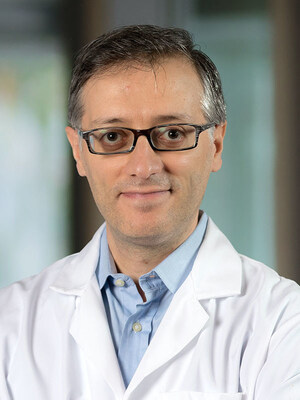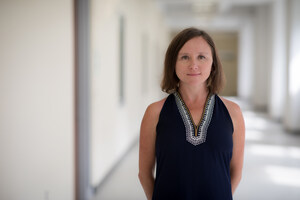BRONX, N.Y., April 26, 2018 /PRNewswire-USNewswire/ -- A study in today's issue of JAMA Oncology reports that New York City firefighters exposed to the 9/11 World Trade Center disaster site face an increased risk for developing myeloma precursor disease (MGUS), which can lead to the blood cancer multiple myeloma. The study was conducted by researchers at Albert Einstein College of Medicine, Montefiore Health System, the Fire Department of the City of New York (FDNY) and Memorial Sloan Kettering Cancer Center.
"With our 2011 study in The Lancet, we were the first to show that first responders were more likely to get many different types of cancer," said senior co-author David J. Prezant, M.D., a professor of medicine at Einstein, a pulmonary disease specialist at Montefiore and chief medical officer of the FDNY. "We carried out this new study to do more than just treat cancer. We wanted to find early, predictive signs of cancer that would allow us to screen people and monitor those found to be at risk. By detecting MGUS, which predicts the development of multiple myeloma, we are able to do that."
In MGUS (monoclonal gammopathy of undetermined significance), the blood's plasma cells produce an abnormal protein called monoclonal (M) protein that can be detected with blood tests. MGUS generally causes no problems but can progress to multiple myeloma, a blood cancer diagnosed in about 30,000 Americans each year. In multiple myeloma, rapidly proliferating plasma cells can crowd out the bone marrow's normal blood-forming cells, leading to problems including anemia (shortage of red cells) and leukopenia (shortage of white cells). Most multiple myeloma cases are diagnosed in people older than 65, and only 5 percent of cases occur among people under 50. Half of those diagnosed with multiple myeloma are still alive five years later.
Previous studies suggest that MGUS and multiple myeloma all tend to develop after exposure to toxic chemicals. The aerosolized dust from the collapsed towers exposed FDNY and other first responders to unprecedented levels of polychlorinated biphenyls, polycyclic aromatic hydrocarbons, dioxins, asbestos and other potential carcinogens, as well as diesel smoke from heavy machinery used in the 10-month rescue and recovery effort.
For statistical reasons, the study population was limited to 781 white, male WTC-exposed firefighters aged 50 to 79 whose blood samples were evaluated to assess the prevalence of MGUS in the group. When results were compared with MGUS prevalence in a non-exposed comparison group (men living in Olmsted County, MN), the prevalence of MGUS in the firefighters was nearly twice as high (7.63 cases of MGUS per 100 firefighters vs. 4.34 cases per 100 non-exposed persons).
"We saw a significantly higher incidence of MGUS in these first responders, and they're developing it at a young age," said the study's senior co-author Amit Verma, M.B.B.S., a professor of medicine and of developmental & molecular biology at Einstein and director of hematologic malignancies at the Montefiore Einstein Center for Cancer Care. Their early development of MGUS, he says, suggests that these firefighters potentially face an increased risk for early-onset of multiple myeloma as well.
Indeed, in a separate analysis, the researchers examined the 16 cases of multiple myeloma diagnosed between September 12, 2001 and July 1, 2017 among all white, male WTC-exposed FDNY firefighters. Their average age of diagnosis was 57, or 12 years younger than the average age for multiple myeloma diagnosis nationally.
Although not everyone with MGUS will develop multiple myeloma, the researchers recommend that physicians screen first responders exposed to the WTC site for both conditions. "Screening for multiple myeloma risk by testing for MGUS is something we can offer these first responders, which is why this study is important," said Dr. Prezant.
Another study in this edition of JAMA Oncology predicts how many WTC-related cancer cases will be diagnosed among FDNY WTC exposed rescue/recovery workers between January 1, 2012 and December 31, 2031.The study, by Einstein, Montefiore, and FDNY researchers, predicts that among a subset of white males 2,714 new cancer cases will be diagnosed over the 20-year period. Led by Rachel Zeig-Owens, Dr.P.H., a research assistant professor in epidemiology and population health at Einstein, these studies demonstrate that this is a significantly greater cancer burden than the 2,596 cancer cases that would be predicted in a demographically similar but non-exposed population. The study also calculated that the 20-year cost for the first year of cancer treatment for the FDNY WTC exposed rescue/recovery workers will total more than $235 million. The paper is titled "Estimation of Future Cancer Burden in World Trade Center-Exposed Fire Department of the City of New York Rescue/recovery Workers."
The MGUS study is titled "Multiple myeloma and its precursor disease among firefighters exposed to the World Trade Center disaster." The blood samples for this study were collected and purified under the direction of Orsi Giricz, Ph.D., a co-first author of the study at Montefiore/Einstein, and then analyzed for MGUS by Ola Landgren, M.D., Ph.D., at Memorial Sloan Kettering Cancer Center, the corresponding author for the study. Dr. Zeig-Owen was also a co-first author in this study. The other Einstein and Montefiore authors are David Goldfarb, M.P.H., George Nwankwo, B.S., Ulrich Steidl, M.D., Ph.D., Kith Pradhan, Ph.D., Charles B. Hall, Ph.D., Hillel W. Cohen, Dr.P.H., Theresa Schwartz, M.S. and Mayris P. Webber, Dr.P.H. Additional authors include Malin Hultcrantz, M.D., Ph.D., Kaznouri Murata, Ph.D., Katie Thoren, Ph.D., Lakshmi Ramanathan, Ph.D., Ahmet Dogan, M.D., Ph.D., and Shani Irby, N.P., all of Memorial Sloan Kettering Cancer Center; Nadie Jaber, PA-C, of the FDNY; and Laura Crowley, M.D. and Michael Crane, M.D., of Mount Sinai School of Medicine.
This work was supported by grants from the V Foundation for Cancer Research, the Byrne Fund, the Memorial Sloan Kettering Core Grant, the Albert Einstein Cancer Center, and the National Institute for Occupational Safety and Health. The authors declare no competing financial interests.
About Albert Einstein College of Medicine
Albert Einstein College of Medicine, part of Montefiore, is one of the nation's premier centers for research, medical education and clinical investigation. During the 2017-2018 academic year, Einstein is home to 697 M.D. students, 181 Ph.D. students, 108 students in the combined M.D./Ph.D. program, and 265 postdoctoral research fellows. The College of Medicine has more than 1,900 full-time faculty members located on the main campus and at its clinical affiliates. In 2017, Einstein received more than $174 million in awards from the National Institutes of Health (NIH). This includes the funding of major research centers at Einstein in aging, intellectual development disorders, diabetes, cancer, clinical and translational research, liver disease, and AIDS. Other areas where the College of Medicine is concentrating its efforts include developmental brain research, neuroscience, cardiac disease, and initiatives to reduce and eliminate ethnic and racial health disparities. Its partnership with Montefiore, the University Hospital and academic medical center for Einstein, advances clinical and translational research to accelerate the pace at which new discoveries become the treatments and therapies that benefit patients. Einstein runs one of the largest residency and fellowship training programs in the medical and dental professions in the United States through Montefiore and an affiliation network involving hospitals and medical centers in the Bronx, Brooklyn and on Long Island. For more information, please visit www.einstein.yu.edu, read our blog, follow us on Twitter, like us on Facebook, and view us on YouTube.
SOURCE Albert Einstein College of Medicine
Related Links
WANT YOUR COMPANY'S NEWS FEATURED ON PRNEWSWIRE.COM?
Newsrooms &
Influencers
Digital Media
Outlets
Journalists
Opted In






Share this article